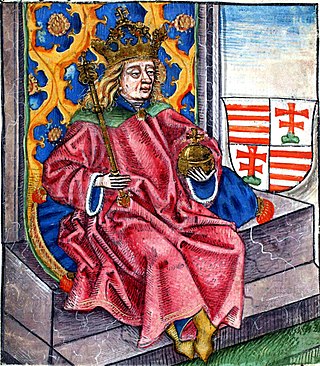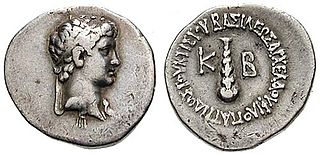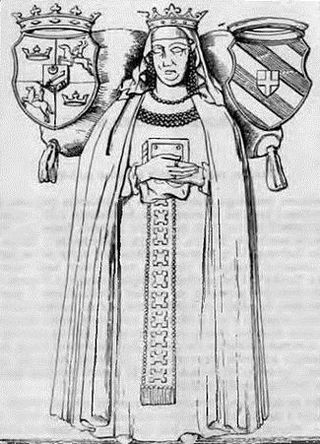
Drypetina, Dripetrua (died c. 66 BC) was a devoted daughter of King Mithridates VI of Pontus and his sister-wife Laodice.

Drypetina, Dripetrua (died c. 66 BC) was a devoted daughter of King Mithridates VI of Pontus and his sister-wife Laodice.
Her name is the diminutive form of the name of Drypetis, daughter of the Achaemenid king Darius III. [1] She had a double row of teeth. [2] According to Ammianus Marcellinus, during the Third Mithridatic War, Drypetina, severely ill, was left behind in the fortress of Sinora under the protection of the eunuch Menophilus. When the Roman forces under Mallius Priscus besieged the fortress, Menophilus killed the princess to prevent her from being captured by the Romans and then committed suicide (Amm. Marc. XVI.7.10). [3] She appears in De Mulieribus Claris by Giovanni Boccaccio as "Dripetrua, queen of Laodicea".[ citation needed ]

Septimia Zenobia was a third-century queen of the Palmyrene Empire in Syria. Many legends surround her ancestry; she was probably not a commoner and she married the ruler of the city, Odaenathus. Her husband became king in 260, elevating Palmyra to supreme power in the Near East by defeating the Sasanian Empire of Persia and stabilizing the Roman East. After Odaenathus' assassination, Zenobia became the regent of her son Vaballathus and held de facto power throughout his reign.

Roxana was a Sogdian or a Bactrian princess who Alexander the Great married after defeating Darius, ruler of the Achaemenid Empire, and invading Persia. The exact date of her birth is unknown, but she was probably in her early teens at the time of her wedding.

Béla IV was King of Hungary and Croatia between 1235 and 1270, and Duke of Styria from 1254 to 1258. As the oldest son of King Andrew II, he was crowned upon the initiative of a group of influential noblemen in his father's lifetime in 1214. His father, who strongly opposed Béla's coronation, refused to give him a province to rule until 1220. In this year, Béla was appointed Duke of Slavonia, also with jurisdiction in Croatia and Dalmatia. Around the same time, Béla married Maria, a daughter of Theodore I Laskaris, Emperor of Nicaea. From 1226, he governed Transylvania as duke. He supported Christian missions among the pagan Cumans who dwelled in the plains to the east of his province. Some Cuman chieftains acknowledged his suzerainty and he adopted the title of King of Cumania in 1233. King Andrew died on 21 September 1235 and Béla succeeded him. He attempted to restore royal authority, which had diminished under his father. For this purpose, he revised his predecessors' land grants and reclaimed former royal estates, causing discontent among the noblemen and the prelates.
Brunhilda was queen consort of Austrasia, part of Francia, by marriage to the Merovingian king Sigebert I of Austrasia, and regent for her son, grandson and great-grandson.
García Sánchez I, was the king of Pamplona from 925 until his death in 970. He was the second king of the Jiménez dynasty, succeeding his father when he was merely six years old.

Until the end of the Ethiopian monarchy in 1974, there were two categories of nobility in Ethiopia and Eritrea. The Mesafint, the hereditary nobility, formed the upper echelon of the ruling class. The Mekwanint were the appointed nobles, often of humble birth, who formed the bulk of the aristocracy. Until the 20th century, the most powerful people at court were generally members of the Mekwanint appointed by the monarch, while regionally, the Mesafint enjoyed greater influence and power. Emperor Haile Selassie greatly curtailed the power of the Mesafint to the benefit of the Mekwanint, who by then were essentially coterminous with the Ethiopian government.

Archelaus was a Roman client prince and the last king of Cappadocia. He was also husband of Pythodorida, Queen regnant of Pontus.

Roman I was Voivode of Moldavia from December 1391 to March 1394. He was the second son of Costea and Margareta Muşata the daughter of the first ruler of Moldavia, Bogdan I and the founder Muşatin family.

Catherine of Bosnia was Queen of Bosnia as the wife of King Thomas, the penultimate Bosnian sovereign. She was born into the powerful House of Kosača, staunch supporters of the Bosnian Church. Her marriage in 1446 was arranged to bring peace between the King and her father, Stjepan Vukčić. The queenship of Catherine, who at that point converted to Roman Catholicism, was marked with an energetic construction of churches throughout the country.

Leonor Teles was queen consort of Portugal by marriage to King Ferdinand I, and regent of Portugal during the minority of her daughter in 1383-1384. She was one of the protagonists, along with her brothers and her daughter Beatrice, of the events that led to the succession crisis of 1383–1385, which culminated in the defeat of her son-in-law King John I of Castile and his armies in the Battle of Aljubarrota. Called "the Treacherous" by her subjects, who execrated her on account of her adultery and treason to her native country, she was dubbed by the historian Alexandre Herculano as "the Portuguese Lucrezia Borgia".
The history of Chester extends back nearly two millennia, covering all periods of British history in between then and the present day. The city of Chester was founded as a fort, known as Deva Vitrix, by the Romans in AD 70s, as early as AD 74 based on discovered lead pipes. The city was the scene of battles between warring Welsh and Saxon kingdoms throughout the post-Roman years until the Saxons strengthened the fort against raiding Danes.
Lycomedes of Comana was a Bithynian nobleman of Cappadocian Greek descent who ruled Comana, Cappadocia in the second half of the 1st century BC.

Mithridates or Mithradates VI Eupator was the ruler of the Kingdom of Pontus in northern Anatolia from 120 to 63 BC, and one of the Roman Republic's most formidable and determined opponents. He was an effective, ambitious and ruthless ruler who sought to dominate Asia Minor and the Black Sea region, waging several hard-fought but ultimately unsuccessful wars to break Roman dominion over Asia and the Hellenic world. He has been called the greatest ruler of the Kingdom of Pontus. He cultivated an immunity to poisons by regularly ingesting sub-lethal doses; this practice, now called mithridatism, is named after him. After his death, he became known as Mithridates the Great.
Dynamis, nicknamed Philoromaios, was a Roman client queen of the Bosporan Kingdom during the Late Roman Republic and part of the reign of Augustus, the first Roman Emperor. Dynamis is an ancient Greek name which means the “powerful one”. She was a monarch of Iranian and Greek Macedonian ancestry. She was the daughter of King Pharnaces II of Pontus and his Sarmatian wife. She had an older brother called Darius and a younger brother called Arsaces. Her paternal grandparents had been the monarchs of the Kingdom of Pontus, Mithridates VI of Pontus and his first wife Laodice, who was also his sister. Dynamis married three times. Her husbands were Asander, a certain Scribonius and Polemon I of Pontus. According to Rostovtzeff, she also had a fourth husband, Aspurgos.
Monime, sometimes known as Monima, was a Macedonian Greek noblewoman from Anatolia and one of the wives of King Mithridates VI of Pontus.
Stratonice of Pontus was a Greek woman from the Kingdom of Pontus who was one of the mistresses and the fourth wife of King Mithridates VI of Pontus.
Orsabaris, also spelt as Orsobaris was a Princess of the Kingdom of Pontus. She was a Queen of Bithynia by marriage to Socrates Chrestus and later married to Lycomedes of Comana.
Orodaltis was an ancient princess who may have ruled the city of Prusias ad Mare in Anatolia. She was a contemporary to the first Roman Emperor Augustus, who ruled from 27 BC to 14 AD.
Çayıryolu, formerly Sünür, is a village in the Bayburt District, Bayburt Province, Turkey. Its population is 231 (2021). Before the 2013 reorganisation, it was a town (belde). The village has a historic mosque and mausoleum.

The Castle of Bragança is a well-preserved medieval castle located in the historic center of the city of Bragança, district of Bragança, Portugal.